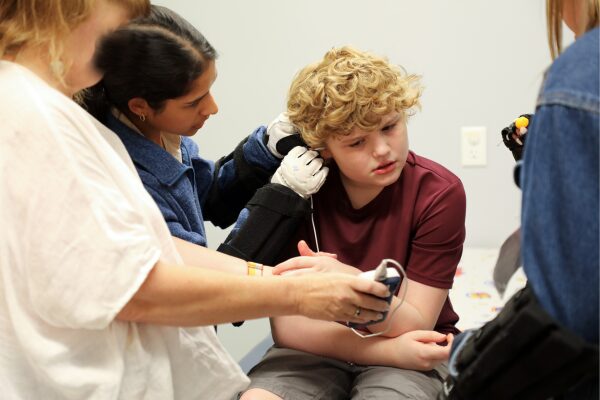December 1, 2024
NECC’s Onsite Hearing Tests Promote Student Success

For children with autism, completing medical procedures can be an immense challenge. In Massachusetts, hearing screenings are mandatory for all students, which in the past has required NECC staff and students to invest in a full-day trip to Boston. As a way to alleviate the stress of this resource-intense process, the Speech and Language Department has implemented a system to perform these screenings using a less invasive test onsite at NECC Southborough.
“Performing hearing screenings on-site decreases the need to travel to hospital-based audiologists and uses fewer staff resources, requires less time, and improves the student’s overall experience with a simple medical procedure,” shared Beth Bellone, MS, CCC-SLP, BCBA, LABA, director of speech and language services.
Bellone explained that to accomplish this, there needed to be a collaborative approach involving nurses, speech pathologists, and behavior analysts. “By leveraging our expertise and working together, we created a supportive environment with strategies to ease the process for our students,” she said.
Recognizing that sensory sensitivities, communication difficulties, and anxiety can all play a role during a student’s appointment, the team took the time to introduce students to the equipment and procedures in a clear and visual manner. For some students, additional steps were designed with supervising BCBAs to improve tolerance of the equipment and tests.
According to Bellone, it is difficult for children with autism to respond to the behavioral expectations of a typical hearing test (listening to quiet sounds, raising hands, responding appropriately to a sound, etc.). The screenings performed at NECC take less than two minutes and use a specialized device to test how well the inner ear, or cochlea, works by measuring otoacoustic emissions (OAEs), which are sounds produced by the cochlea’s outer hair cells when stimulated by external sounds.
“If our students pass the hearing screening at NECC using this less intrusive method, we can save our staff resources to transport students only when they meet the hearing thresholds requiring a referral,” said Bellone.
“Students have been amazingly receptive to this new procedure,” shared Bellone. “Without much training, our students have been patient and responsive. This has resulted in incredibly successful participation for students who historically had challenges in these settings.”